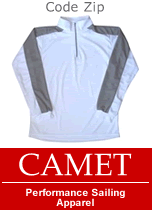

BT Boats KIWI 40FC launch in Auckland - photos Renata Minetto
At 08:00 on Tuesday morning New Zealand-time, the first KIWI 40FC Class40 was launched at Pier 21 in Auckland. The brainchild of Lapo Ancillotti and Francesco Piva of BT Boats, the latest Class40 design is the result of a collaboration between Farr Yacht Design and Cookson Boats and the forthcoming sea trials will be closely followed by Class40 sailors.
For Lapo Ancillotti of BT Boats, the project has been highly-demanding, but exciting and rewarding: “Our first objective has been reached with the launch of the first KIWI 40FC,” he confirmed on Tuesday. “Everything has gone according to plan so far and the boat will now begin an intense program of speed tests and sea trials in Auckland and Wellington.” Following the launch, the yacht was moved to the Viaduct basin as a temporary base. “The launch of the first boat is a landmark moment for us,” admits Ancillotti. “After ten long and intense months, we finally get to go to sea and test the boat that we have dedicated so much energy to. On behalf of myself and Francesco, I would like to thank Farr Yacht Design and Cookson Boats for the excellent job they have done, the professionalism shown, and the dedication that allowed us to realize an outstanding Class40 yacht.”
The KIWI 40FC is the first Class40 for Farr Yacht Design (FYD) and their offshore racing background was invaluable throughout the design process. Patrick Shaughnessy, President of FYD explains: “Farr Yacht Design's work on Volvo Open 70 and IMOCA 60 designs has had a big influence on the development of the KIWI 40FC,” says Shaughnessy. “Our experience in these classes has certainly improved our understanding of boat handling and ergonomics when sailing shorthanded in the open ocean.”
Part of the early design process utilized CFD (Computational Fluid Dynamic) programs in collaboration with the Stevens Institute of Technology. “Developing this design, we utilized many of the research techniques, including CFD, that have been refined for Volvo Ocean Race development,” he continues. “We have utilized our whole tool set to produce a powerful, low drag hull shape well-suited to offshore sailing.” Through the design evolution process, hull form; chines; transom immersion; longitudinal hull shape; bow-fullness and section style were refined and FYD estimate that they have reduced overall drag by three to five per cent in some conditions.
read more







